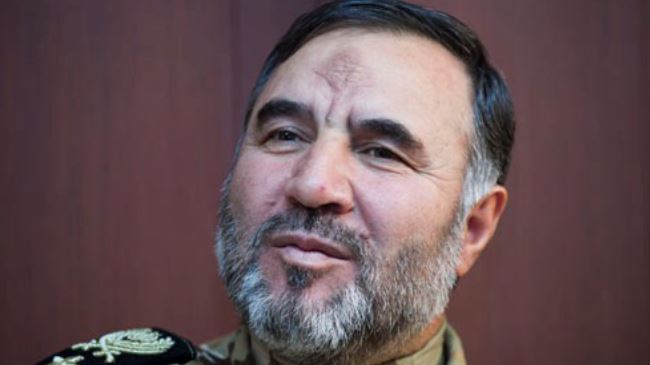 Lieutenant Commander of the Iranian Army's Ground Forces Brigadier General Kiumars Heidari[/caption]
Lieutenant Commander of the Iranian Army's Ground Forces Brigadier General Kiumars Heidari[/caption]TEHRAN (FNA)- Lieutenant Commander of the Iranian Ground Force Brigadier General Kioumars Heidari announced on Monday that Iran has successfully tested three suicide combat drones in the recent Mohammad Rasoulallah (PBUH) wargames.
"We tested three models of suicide unmanned aerial vehicles (UAVs), which were a type of cruise missiles and have been fully manufactured by Iranian experts," General Heidari told reporters on Monday.
He noted that the tested drones enjoy a very advanced technology and were from Ra'd (Thunder) 85 Class.
Iran has recently made giant advancements in aerospace industries, specially in designing and manufacturing pilotless drones.
Iran in November unveiled a newly-developed drone named 'Ababil 3' which is capable of flying a maximum altitude of 15,000 ft.
The drone can fly for 8 hours non-stop and has a composite body and can take and send real-time images to the ground control stations or any other platform.
In September, Iran unveiled another new home-made drone named 'Sadeq 1' during the military parades at the mausoleum of the Founder of the Islamic Republic, the Late Imam Khomeini, South of the capital.
Sadeq 1 flies at a maximum altitude of 25,000 ft at supersonic speeds. The Iran-made drone has been manufactured for testing radar and electronic systems and training assessments.
In September 2012, Iran announced that it had started using UAVs in its air defense units as part of its broader plans for strengthening the country's air defense capability.
In December 2013, Commander of the Islamic Revolution Guards Corps Major General Mohammad Ali Jafari said the Islamic Revolution Guards Corps (IRGC) was capable of mounting guided missiles and bombs on its drones.
�We have recently acquired the capability to mount guided and precision-targeting missiles with pinpointing capability and bombs on drones, which is actually among branches of advanced hi-tech in this field,� Jafari told reporters in Tehran at the time.
He referred to Iran�s latest achievements in building drones, and said, �Our latest achievement in this regard is a drone which can fly for 30 hours and high-speed engines can increase its range.�
Also in November 2013, Iranian Defense Minister Brigadier General Hossein Dehqan announced that Iran's new drone enjoys unique strategic capabilities, including 30-hour-long flight durability, and had been developed for combat and surveillance missions.
Dehqan said the new drone, �Fotros�, had been designed and built by the Iranian Airplane Manufacturing Industries Company affiliated to the Defense Ministry�s Aviation Industries in cooperation with knowledge-based companies and academic centers and on the basis of the needs of the country�s Armed Forces.
�This strategic drone has an operational range of 2,000 kilometers, and can fly to a ceiling of 25,000 feet in altitude for 16 to 30 hours, and these specifications enable it to conduct combat missions in addition to surveillance and reconnaissance missions," Dehqan said addressing a ceremony held in Tehran to unveil the new drone.
The minister said Fotros could be armed with various types of "air-to-surface missiles and rockets".
He underlined that the reliability test of the drone had been successfully conducted in the country�s laboratories and test centers, including standard international land tests at low, medium and high speed, adding that test results have been even better than what was expected.
The minister further pointed to the missions which could be done by Fotros in detail, and said the drone could be used for �protecting land and sea borders, monitoring oil pipelines, telecommunication lines and road traffic control, monitoring affected areas during earthquakes, blaze and floods, and environment protection", adding that it can send "real-time photos and images while it is on a missions".
He reiterated that Iran�s Defense Ministry had become self-sufficient in designing and manufacturing different kinds of defensive, offensive and surveillance drones.
General Dehqan underlined that Iranian researchers were then working on various models and designs of drones according to the country�s defensive needs.
Also in September 2012, Iran announced that it had started using UAVs for its air defense units as part of its broader plans for strengthening the country's air defense capability.
Speaking to reporters on the occasion of the National Day of Air Defense here in Tehran on September 3, 2012, Commander of Iran's Air Defense Unit Brigadier General Farzad Esmayeeli said Iran had equipped its air defense units with Haazem drones. Haazem is a drone designed and manufactured by Iranian air defense experts in three short, mid and long range models and for air defense missions.
The drone can be used as a target for air defense systems and also for reconnaissance missions.
The UAV can also be equipped with missiles and used for aerial bombardments as well.
By Fars News Agency
The Iran Project is not responsible for the content of quoted articles.










